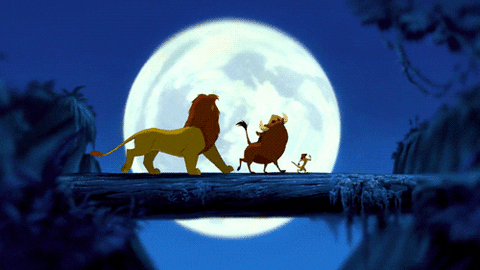The term “Renaissance” has been used by fans to describe the awakening and reinvention that brought public and critical interest to Disney Feature Animation in the 1990s. We started revisiting these innovative filmmaking techniques with Aladdin, and will periodically reflect on the rest of the Renaissance films.
How can we become better filmmakers by re-watching these famous animated features? Let’s continue by looking at The Lion King (1994).
1. Explore pre-existing material
It’s no big secret most animated Disney films are based on something. Fairy tales and fables are among the sources that have inspired some of our favorites. Although The Lion King is generally considered an “original” story, it uses some pretty clear elements from somewhat unusual sources (well, depending on who you ask). There is, of course, the controversy surrounding the idea that The Lion King was plagiarized. But, according to the filmmakers, the Lion King borrows story ideas from Shakespeare’s Hamlet, in which the evil uncle vies for the throne.

The writers have also said they took a cue from one of the most popular books of all time: The Bible. Specifically, elements from the stories of Moses and Joseph. Remember, these works (and most fairy tales) are public domain. You’d be surprised at the amount of classic works that will be fair game for repurposing and reimagining in the coming years. So don’t hesitate to look into existing works for ideas, and your film’s end result might be something iconic in its own right.
2. Employ motifs and symbolism
Stories can be told with so much more than words, or even actions. One of a filmmaker’s most valuable tools is their sensitivity to symbolism. If you start looking at every shot as an opportunity to imbue meaning and intention, the film will be that much stronger and resonate more with your audience.

The Lion King is constantly playing with these ideas, however small and imperceptible they may be. For example, the use of wind is a common motif throughout the film. It is a physical manifestation of the idea of the “circle of life,” as it represents Mufasa. The wind appears in the opening scene as it brushes across Mufasa’s mane. Later in the film it carries leaves and other debris that Rafiki recognizes as Simba not only being alive, but capable of fulfilling his destiny. It shows up again at the very end of the film, as Simba presents his new daughter Kira.
Fire and rain play a symbolic role in the climax of the film as well. Fire symbolizes anger, destruction, and death, whereas rain represents new beginnings, healing and life. It is no accident (obviously, as it’s an animated film!) that rain begins to pour as Simba completes his character arc and takes his rightful place in the kingdom. The water washes away an animal skull, symbolizing the shift from death to new life. Use every opportunity to imbue the world you’re building with meaning!
3. Shoot for the stars
It’s common today to cast an ensemble of A-list talent to do your voice work, but it wasn’t always that way. Whether your cast is full of celebrities, or merely led by one notable actor, it’s a great way to raise funding and entice fans to see the film.

The Lion King featured many notable actors: Jeremy Irons (Scar), Jonathan Taylor Thomas (Young Simba), Matthew Broderick (Adult Simba), Nathan Lane (Timon), James Earl Jones (Mufasa), and Whoopi Goldberg (Shenzi). Not to mention Elton John on the soundtrack!
This star-laden cast was unusual for the time, and definitely helped draw viewers into those theater seats. In 2019, the roster for the live-action Lion King remake boasts arguably even bigger talent. Even if you can’t afford the likes of Beyonce, just one name actor with a solid track record will help you draw dollars and eyeballs.
4. Study film history
If you’re a fan of film history, you’re familiar with some of the stylistic movements, such as Magical Realism, Impressionism, and German Expressionism. If you aren’t familiar…it’s time to brush up!

Renaissance Disney is no stranger to film history. One notable example is the art direction in the song “Be Prepared”. The influences of German Expressionism are hard to miss, providing not only a visual treat but also deeper meaning and context to Scar’s dastardly mentality. German Expressionism, defined by sharp edges, distortion, darkness, and shadows, was a style popular in early cinema, specifically in late 1910’s Germany.
This style is quite clearly echoed in “Be Prepared,” particularly as the Hyena’s sharp-edged goose-stepping shadows dramatically pass in front of the bright green light of the elephant graveyard’s geysers. These visuals are vastly different from the more colorful, happy-go-lucky look the rest of the film. They also hold a lot of subtext, linking the Scar and his lackeys with Nazi Germany. The takeaway: don’t forget to dive into history and film theory to find new visual inspiration.
5. Find your sub-genre
“Animated Musical” would be the most likely candidate for The Lion King’s genre, but there’s certainly more to it than that. The film is so relatable because The Lion King commits to its sub-gene, the “Coming-of-Age” story. There is little about The Lion King that actually requires lions to be part of the story, because Simba’s struggles are very human.

Simba’s arc follows that of a naive youth who thinks everything should be handed to him, to an adolescent questioning his place in the world, to an adult finally taking responsibility. The beats of the coming-of-age genre are comfortable and familiar to the viewer, so they can focus on what’s universal about the story. Whether you’re making an “action-adventure” or “futuristic sci-fi” film, commit to a sub-genre to better connect with your audience.

